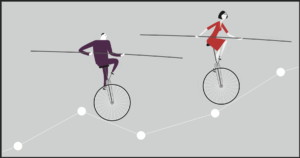
In this increasingly sensitized world, we sometimes wonder how others will interpret our words.
On the receiving end, we may be offended by others’ comments and wonder, at a minimum, how this person could have been so insensitive.
Layer on to these differences in cultures and life experiences; while some may hear a comment as a big deal, the sender may be left scratching their head.
For me, the solution lies in dialogue and seeking first to understand. Understand what others are sensitive to, the life and ancestral experiences that may have led them to feel as they do, and why others appear to “not get it.”
Two conversations, one recent and one I had a few years back, brought this home to me at a personal level. In the recent conversation, as a Jewish person, I felt offended by comments I heard from a friend—comments that my friend may have felt were neutral.
This recent experience reminded me of a conversation a few years ago with a black friend when I was perceived as insensitive. “You don’t understand my history and lived experience,” she said. I felt sad and misunderstood at the time because I thought I did understand. I realize now that her comments were accurate; I do not understand. Each of us sees the world through our filter.
Sometimes, we think what is right and what is wrong should be obvious, yet it often isn’t. One of my favorite examples comes from Trevor Noah’s biography.
According to Noah, in South Africa, where he is from, children are taught that Hitler was a powerful man; the atrocities he committed were left out of the history lesson. Trevor goes on to say that black South Africans often name their children after “great leaders,” emphasizing that great does not necessarily mean good. With this background in mind, Noah shares a story about a friend named Hitler. Yes, that is his given name, not a nickname.
As young adults, Trevor and Hitler were entertainers; Trevor was a DJ, and Hitler was a dancer. The two of them were invited to perform at a school in a white neighborhood that turned out also to be a Jewish neighborhood. When Trevor introduces Hitler to the stage to dance, the room falls silent. Trevor doesn’t understand why and carries on with his spiel using Hitler’s name over and over.
Finally, a teacher comes on stage and demands that they leave. An argument ensues; the teacher is horrified that “you people” had the indecency to come here. Trevor hears “you people” as black people; now both are horrified and offended. Trevor and Hitler leave, and it isn’t until years later, when Trevor travels outside of South Africa, that he understands what happened that day.
When I read Noah’s story, I was struck by its absurdity and reminded that we must try to assume positive intent, which is hard to do sometimes but so important, especially today.









 The initial results of my Pivot are excellent. I feel I have much greater clarity regarding the next 3-5 years..
The initial results of my Pivot are excellent. I feel I have much greater clarity regarding the next 3-5 years.. 